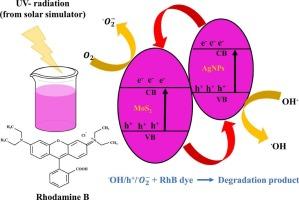Protein-exfoliation mediated molybdenum disulfide incorporated with silver nanoparticles for photocatalytic degradation of Rhodamine B
IF 4.6
3区 材料科学
Q2 MATERIALS SCIENCE, MULTIDISCIPLINARY
引用次数: 0
Abstract
Application of dyes in textiles and other industries may pose a significant threat to human health and the environment. Therefore, the development of efficient photocatalyst materials for dye degradation is crucial. This study presents the synthesis of a nanocomposite comprising exfoliated molybdenum disulfide (Exf-MoS2) and silver nanoparticles (AgNPs) using the exfoliation method followed by the hydrothermal method for RhB dye degradation. The effects of various parameters, including catalyst type, namely, Exf-MoS2, AgNPs-2, Exf-MoS2/AgNPs-1, Exf-MoS2/AgNPs-2, and Exf-MoS2/AgNPs-3, Rhodamine B dye concentration, silver concentration within the Exf-MoS2/AgNPs composite, catalyst amount, pH, and stability, were systematically studied. The results demonstrated photocatalytic degradation efficiencies of 68.06%, 82.47%, 88.82%, 98.60%, and 98.89% for Exf-MoS2, AgNPs-2, Exf-MoS2/AgNPs-1, Exf-MoS2/AgNPs-2, and Exf-MoS2/AgNPs-3, respectively. Surface modification of Exf-MoS2 with AgNPs significantly enhances the photocatalytic properties of Exf-MoS2/AgNPs due to the plasmonic effect and charge separation, revealing it as an efficient photocatalytic material for RhB dye degradation and wastewater treatment.

蛋白质剥离介导的二硫化钼结合纳米银用于罗丹明B的光催化降解
染料在纺织品和其他工业中的应用可能对人类健康和环境构成重大威胁。因此,开发用于染料降解的高效光催化材料至关重要。本研究采用剥离法和水热法合成了一种由脱落二硫化钼(Exf-MoS2)和银纳米粒子(AgNPs)组成的纳米复合材料,用于RhB染料的降解。系统研究了催化剂类型(即Exf-MoS2、AgNPs-2、Exf-MoS2/AgNPs-1、Exf-MoS2/AgNPs-2、Exf-MoS2/AgNPs-3)、罗丹明B染料浓度、Exf-MoS2/AgNPs复合材料中的银浓度、催化剂用量、pH和稳定性等参数的影响。结果表明,Exf-MoS2、AgNPs-2、Exf-MoS2/AgNPs-1、Exf-MoS2/AgNPs-2和Exf-MoS2/AgNPs-3的光催化降解效率分别为68.06%、82.47%、88.82%、98.60%和98.89%。利用AgNPs对Exf-MoS2进行表面改性后,由于等离子体效应和电荷分离,Exf-MoS2/AgNPs的光催化性能得到了显著提高,是一种用于RhB染料降解和废水处理的高效光催化材料。
本文章由计算机程序翻译,如有差异,请以英文原文为准。
求助全文
约1分钟内获得全文
求助全文
来源期刊

Materials Science and Engineering: B
工程技术-材料科学:综合
CiteScore
5.60
自引率
2.80%
发文量
481
审稿时长
3.5 months
期刊介绍:
The journal provides an international medium for the publication of theoretical and experimental studies and reviews related to the electronic, electrochemical, ionic, magnetic, optical, and biosensing properties of solid state materials in bulk, thin film and particulate forms. Papers dealing with synthesis, processing, characterization, structure, physical properties and computational aspects of nano-crystalline, crystalline, amorphous and glassy forms of ceramics, semiconductors, layered insertion compounds, low-dimensional compounds and systems, fast-ion conductors, polymers and dielectrics are viewed as suitable for publication. Articles focused on nano-structured aspects of these advanced solid-state materials will also be considered suitable.
 求助内容:
求助内容: 应助结果提醒方式:
应助结果提醒方式:


